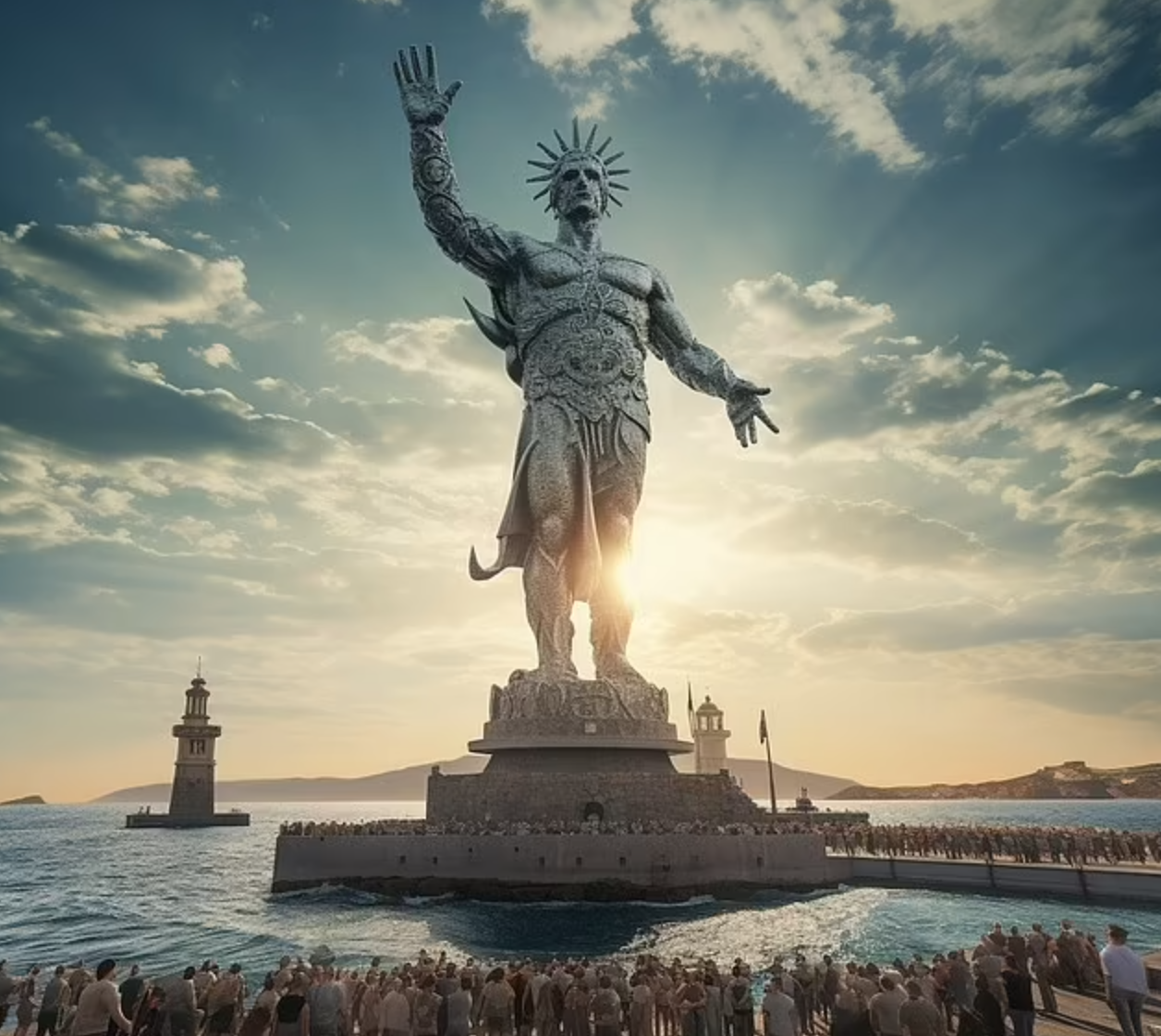Breakthrough AI brings all Seven Wonders of the Ancient World back to life
The seven wonders of the ancient world, a collection of remarkable architectural achievements, have captivated the imaginations of historians

Colossus of Rhodes. Using new AI tools, researchers can create vivid digital models of how these wonders may have once looked. (CREDIT: Midjourney)
For centuries, the Seven Wonders of the Ancient World have stirred fascination. These legendary structures, once towering symbols of human achievement, continue to inspire artists, travelers, and researchers. Each wonder represented a unique blend of creativity, engineering skill, and cultural pride that has echoed through time.
Among them stood marvels like a 100-foot bronze statue guarding a harbor, vast gardens said to float in the air, and a towering lighthouse guiding sailors to safety. There was also an ornate temple covered in gold, a royal tomb carved with incredible detail, and a massive seated god sculpted from ivory and gold. Only one of these masterpieces still stands—the Great Pyramid, a monument that has endured centuries of erosion and upheaval.
The others fell victim to earthquakes, fires, invasions, and decay. The Statue of Zeus was destroyed in a fire. The Lighthouse of Alexandria collapsed after earthquakes. War tore down the Colossus. The Hanging Gardens, if they existed at all, left behind no clear trace. Time buried the rest beneath rubble and memory. Most of what we know comes from ancient texts and scattered ruins.
Now, artificial intelligence is helping to rebuild what history lost. Using new AI tools, researchers can create vivid digital models of how these wonders may have once looked. These reconstructions bring forgotten brilliance back to life—towering columns, lush terraces, and golden statues rising again, at least in pixels. Through AI, we glimpse the grandeur that once ruled the ancient world.
Great Pyramid of Giza: A Timeless Marvel
In the heart of Egypt, the Great Pyramid of Giza remains the sole survivor of the original Seven Wonders of the World. Built by ancient Egyptians, this extraordinary monument has stood the test of time, drawing countless tourists to its impressive presence.
The pyramid was constructed using massive limestone blocks, some weighing up to 2.5 tons, and took an astonishing 20 years to complete.
AI has resurrected the Great Pyramid in its original glory, restoring the gleaming white limestone that once adorned its surface but has since eroded over the millennia. The pyramid continues to be a symbol of human ingenuity and an enduring testament to ancient civilization.
Related Stories
Colossus of Rhodes: A Grand Welcome to Visitors
Among the lost wonders of the ancient world, the Colossus of Rhodes stands out for its colossal stature and intriguing history. This monumental bronze statue, rising to a towering height of 100 feet, depicted the Greek god of the sun, Helios.
The ancient artwork often portrayed the statue straddling the entrance to the harbor, but recent research suggests that it actually stood on a pedestal near the harbor's entrance, welcoming ships from afar.
Constructed over the course of 12 years, the Colossus of Rhodes was a testament to ancient engineering and artistry. Sadly, its reign was short-lived, as an earthquake sealed its fate, toppling it less than a century after its completion in 282 BC. Thanks to AI, we can now marvel at this awe-inspiring structure once more.
Hanging Gardens of Babylon: A Mythical Oasis
The Hanging Gardens of Babylon have long been shrouded in mystery and legend. According to ancient texts, these gardens featured elaborate terraces, magnificent water features, and floating plants. However, there is no concrete evidence of their existence, and their true location remains a subject of debate.
Legend tells us that these lush gardens would have been situated approximately 50 miles south of Baghdad in Iraq. Some sources attribute their creation to Babylonian Emperor Nebuchadnezzar, who supposedly built them for his wife Amyitis.
Curiously, neither the Emperor nor his wife left any written records mentioning these fabled gardens. If they ever existed, they likely met their demise when the Achaemenid Empire conquered Babylon in 539 BC.
Statue of Zeus at Olympia: A Godly Marvel
In Olympia, Greece, the Statue of Zeus was created as a dazzling display of divine grandeur. Standing at an imposing height of 40 feet, this statue crafted from ivory sat upon a majestic throne inside an airy temple. Olympia's residents commissioned this awe-inspiring figure in an attempt to outshine their rivals in Athens.
While the original statue no longer graces our world, AI has brought it back to life in a digital reimagining. In this digital recreation, tourists can now gather around the magnificent statue, experiencing the grandeur of Zeus as it once was. Historical records tell us that the statue met its end in a devastating fire that consumed Constantinople in 426 AD.
Lighthouse of Alexandria: A Guiding Beacon
The Lighthouse of Alexandria, once a towering monument to human innovation, stood more than 350 feet tall on Pharos Island in the ancient Egyptian harbor.
Designed by Sostratus of Cnidus, this complex structure showcased both the intellectual and mathematical prowess of its time. Its design included a burning fire atop a cylindrical tower, an octagonal middle section, and a square base.
Despite its grandeur, the Lighthouse of Alexandria fell into disrepair and eventual ruin due to a series of destructive earthquakes in the Middle Ages. AI, however, has breathed new life into this historical marvel, presenting it to the world as it once stood, unscathed by the ravages of time.
Mausoleum at Halicarnassus: A Monument to the Past
The Mausoleum at Halicarnassus was constructed in 350 BC in modern-day Turkey as a tribute to Mausolus, the ruler of Caria. Its architectural brilliance combined Greek, Near Eastern, and Egyptian design principles, featuring Anatolian and Pentelic marble in its construction. In its prime, it was a testament to the artistic and engineering achievements of its time.
AI has reimagined this monumental tomb, allowing tourists to ascend its grand staircase and witness the wonder that once held the remains of Mausolus. Excavations at the site revealed sacrificial remains of oxen, sheep, and birds, remnants of a ceremonial feast held in honor of the Mausoleum's permanent occupant.
Unfortunately, the Mausoleum met its demise in the 13th century, succumbing to a series of earthquakes.
Temple of Artemis at Ephesus: A Marvel of Marble and Gold
The Temple of Artemis at Ephesus holds a storied history of construction and destruction. The most famous iteration of this temple was erected around 550 BC with the financial backing of King Croesus of Lydia. Distinguished by its use of marble and embellished with gold, it stood as a glittering testament to the goddess Artemis.
Tragically, the temple faced a series of calamities throughout its existence. Herostratus, seeking infamy, set it ablaze. The Goths later contributed to its destruction while fleeing from the Romans.
Finally, in 401 AD, a Christian mob dismantled the temple, leaving only its foundations and a single column, which still stands as a reminder of the grandeur that once graced Ephesus.
While only one of the original Seven Wonders remains standing today, the digital recreations of these marvels serve as a testament to the enduring human spirit and our boundless curiosity about the mysteries of the past.
Note: Materials provided above by The Brighter Side of News. Content may be edited for style and length.
Like these kind of feel good stories? Get The Brighter Side of News' newsletter.



